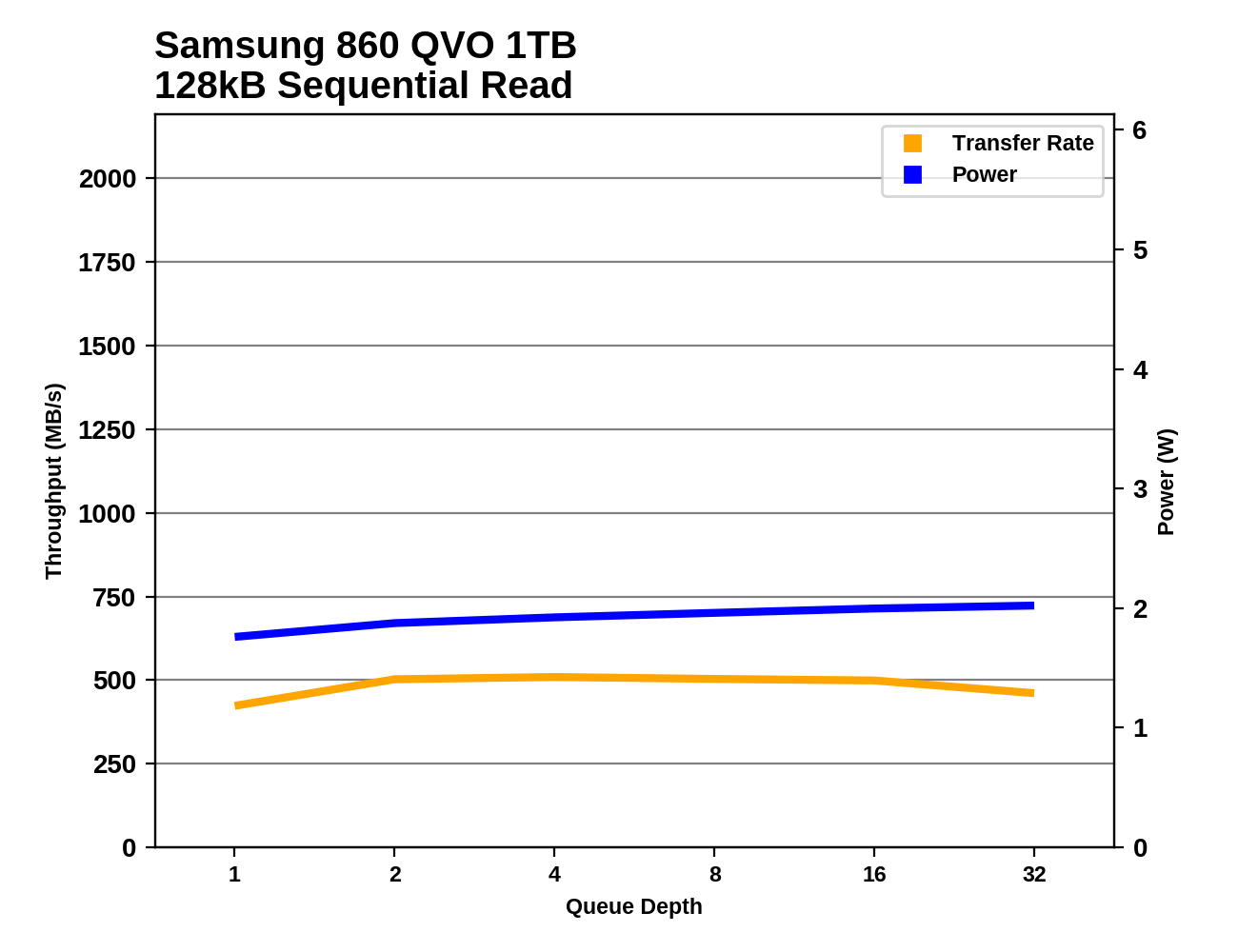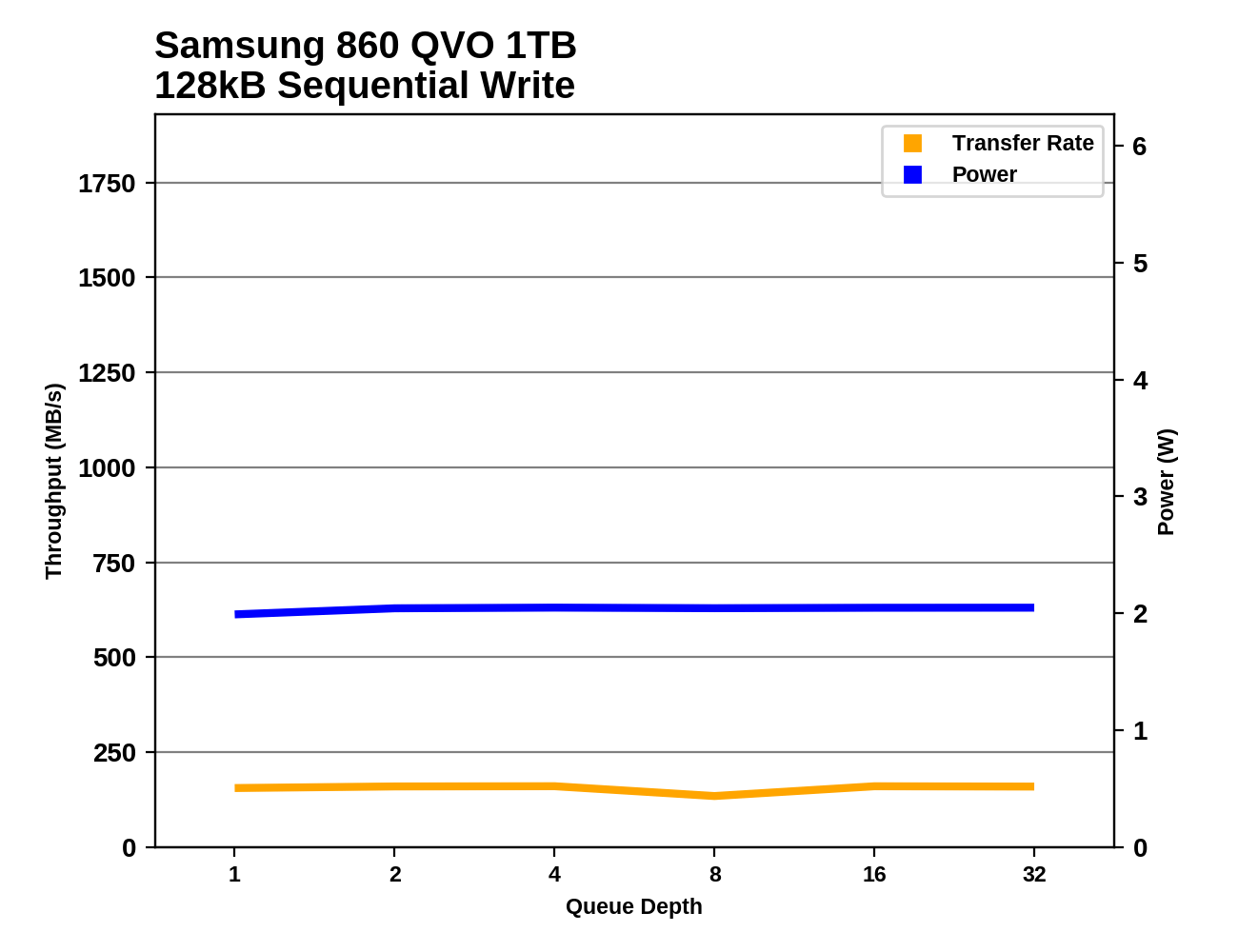The Samsung 860 QVO (1TB, 4TB) SSD Review: First Consumer SATA QLC
by Billy Tallis on November 27, 2018 11:20 AM ESTSequential Read Performance
Our first test of sequential read performance uses short bursts of 128MB, issued as 128kB operations with no queuing. The test averages performance across eight bursts for a total of 1GB of data transferred from a drive containing 16GB of data. Between each burst the drive is given enough idle time to keep the overall duty cycle at 20%.

The burst sequential read performance of the Samsung 860 QVO is generally competitive with mainstream TLC SATA SSDs and is well ahead of the DRAMless Toshiba TR200. The 1TB 860 QVO's score is a bit lower when the drive isn't full because of the timing of the tests: the drive was still flushing the SLC cache in the background when the read test started.
Our test of sustained sequential reads uses queue depths from 1 to 32, with the performance and power scores computed as the average of QD1, QD2 and QD4. Each queue depth is tested for up to one minute or 32GB transferred, from a drive containing 64GB of data. This test is run twice: once with the drive prepared by sequentially writing the test data, and again after the random write test has mixed things up, causing fragmentation inside the SSD that isn't visible to the OS. These two scores represent the two extremes of how the drive would perform under real-world usage, where wear leveling and modifications to some existing data will create some internal fragmentation that degrades performance, but usually not to the extent shown here.

On the longer sequential read test, the 860 QVO continues to get reasonably close to the SATA speed limit when reading data that is contiguous on the flash itself. Where internal fragmentation is caused by writing to the drive randomly, the QVO's read speed suffers much more than for the TLC drives, and the 1TB 860 QVO ends up slightly slower than a mechanical hard drive.
 |
|||||||||
| Power Efficiency in MB/s/W | Average Power in W | ||||||||
The power efficiency of the 860 QVO is only a little bit lower than the TLC drives for the contiguous data case. When dealing with fragmented data, the QVO is slightly more efficient than the Intel/Micron NVMe QLC drives despite being a bit slower.
 |
|||||||||
The queue depth scaling behavior for the 860 QVO is very typical, with QD1 not quite saturating the SATA link but all higher queue depths hitting close to full speed. The one exception is a slight decrease from the 1TB drive during the final QD32 phase.
Aside from the mild QD32 drop in performance, the sequential read behavior of the 860 QVO doesn't fall outside the normal ranges we've come to expect from TLC drives.
Sequential Write Performance
Our test of sequential write burst performance is structured identically to the sequential read burst performance test save for the direction of the data transfer. Each burst writes 128MB as 128kB operations issued at QD1, for a total of 1GB of data written to a drive containing 16GB of data.

The Samsung 860 QVO handles the burst sequential write test fine when the drive is mostly empty and there's plenty of room in the SLC cache. When the drive is full, the 1TB model's speed suffers somewhat, but is still much faster than the mechanical hard drive or the DRAMless TLC drive.
Our test of sustained sequential writes is structured identically to our sustained sequential read test, save for the direction of the data transfers. Queue depths range from 1 to 32 and each queue depth is tested for up to one minute or 32GB, followed by up to one minute of idle time for the drive to cool off and perform garbage collection. The test is confined to a 64GB span of the drive.

On the longer sequential write test, the SLC cache of the 1TB 860 QVO is not quite enough even when the drive is mostly empty, so it ends up in last place. The 4TB model's SLC cache keeps up with this test and it is as fast as any SATA drive.
 |
|||||||||
| Power Efficiency in MB/s/W | Average Power in W | ||||||||
The 860 QVO is a bit more power-hungry than the 860 EVO, so the 4TB QVO only takes third place for efficiency among the SATA drives in this bunch. The 1TB QVO has similar efficiency to the faster but more power-hungry 1TB QLC NVMe drives from Intel and Micron.
 |
|||||||||
The 1TB 860 QVO is mostly slow and steady during the sequential write test, while the 4TB model's performance is as good as any other SATA drive.
The 1TB 860 QVO's sequential write behavior sticks out clearly as far slower than typical, but it's not unprecedented: there have been TLC drives this slow, but most of them were much smaller than 1TB. The 4TB model blends in with the crowd much better.












109 Comments
View All Comments
Morawka - Wednesday, November 28, 2018 - link
I just had 2 Samsung QLC 3 bit drives die this year alone. They were less than 1.5 year old. I'm never buying Samsung's EVO line again. It will be Pro from here on out. 4 bit drives will fail even faster.Makaveli - Wednesday, November 28, 2018 - link
Which model evo's were those Morawka?And how many writes did they see? what kind of environment did you have them in?
stephenbrooks - Wednesday, November 28, 2018 - link
I was starting to get excited about 2TB for $300 but then I looked up 2TB HDDs and they're about $60. Still a huge price differential especially as I usually want at least one extra drive for nightly backups, although perhaps the backup drive could be the HDD?Lolimaster - Thursday, November 29, 2018 - link
Even with the right capacities for a QLC price is similar or worse than current TLC.Samsunf 860 EVO 1TB $127
For QLC to make sense it should HALF of a TLC else is a ripoff.
s.yu - Friday, November 30, 2018 - link
What's the point of trying to pronounce it? It's just Q-V-O!araczynski - Friday, November 30, 2018 - link
so basically next black friday these should be half price and the 4tb might be worthy of consideration as a Steam drive.thomas-hrb - Friday, November 30, 2018 - link
$149.99 launch price is encouraging even if it is currently more than the 860evo. The 860evo launched for over $300 (closer to $330) and is now $139. If the qvo follows this pattern we can look forward to sub $65 for the 1tb qvo and maybe even $250 for 4tb.Ankou - Friday, November 30, 2018 - link
I think these QLC drives are a bad idea especially in the way they're being marketed. I'm not even talking about performance, the speed reduction I could live with. However, they're orders of magnitude worse in P/E cycles, retention, and endurance. These manufacturers know this and they're preying on the lack of education and focusing on price. Even so far as advertising these drives (this one in particular) as using 4 bit MLC memory (which 4 bit MLC is *always* QLC) implying that it is on safer MLC memory:https://news.samsung.com/global/samsung-electronic...
That is completely a scummy marketing/PR way of doing business.
s.yu - Saturday, December 1, 2018 - link
The fundamental issue is that 2-bit MLC should have been accurately named DLC in the first place, it's not like somebody's gonna mix that up with downloadable content.0ldman79 - Saturday, December 15, 2018 - link
Could we get some numbers from some mechanical drives, WD or Seagate 1TB or 2TB, in comparison to the slower QLC drives?I'd like to see how they hold up against the QLC in random and sustained reads/writes. The latency might be the deciding factor even though I've got some mechanical drives that can beat them on sustained reads/writes.